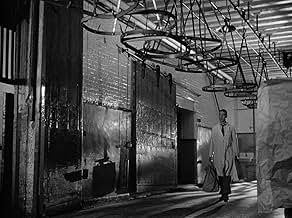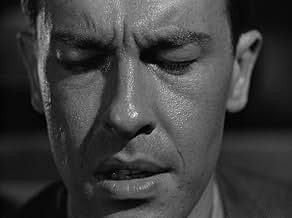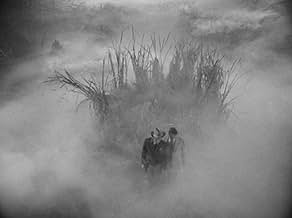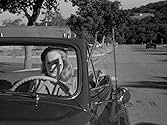VALUTAZIONE IMDb
7,6/10
16.083
LA TUA VALUTAZIONE
Due giovani disturbati liberano il loro fascino per le pistole attraverso una follia criminale.Due giovani disturbati liberano il loro fascino per le pistole attraverso una follia criminale.Due giovani disturbati liberano il loro fascino per le pistole attraverso una follia criminale.
- Regia
- Sceneggiatura
- Star
- Premi
- 1 vittoria in totale
Russ Tamblyn
- Bart Tare (age 14)
- (as Rusty Tamblyn)
David Bair
- Dave Allister (child)
- (as Dave Bair)
Frances Irvin
- Danceland Singer
- (as Frances Irwin)
Recensioni in evidenza
Bart Tare (John Dall) had a fascination with guns from an early age, even getting sent to a reform school at the age of 14 for yet another gun related incident. Back home now as an adult, after a stint in the army, he falls for a sharp-shooting carnival girl called Annie Laurie Starr (Peggy Cummins) and promptly joins the act. But after a fall out with the boss, the pair hit the road and turn to a life of crime - with Annie particularly showing a thirst for gun-play.
No doubt inspired by real life outlaws Bonnie Parker and Clyde Barrow, "Deadly Is the Female" (AKA: Gun Crazy) is as good a "doomed lovers on the lam" picture that has ever been made. It may be a "B" movie in terms of production, but no doubt about it, this film is stylish, crafty and also very sexy. Directed by the unsung Joseph H. Lewis ("My Name Is Julia Ross/The Big Combo"), it's based on a story written by MacKinlay Kantor that was reworked by Millard Kaufman (AKA: the then blacklisted "Dalton Trumbo"), into one that links sex and violence whilst simultaneously casting an eye over gun worship and its place in the American way of life. Dall & Cummings looked on the surface an odd pairing, but under Lewis' direction they go together like gun and holster (ahem). He is well spoken, almost elegantly fragile with his musings, yet underneath there is still this twitchy gun fanatic. She is savvy, almost virginal in sexuality, but ultimately she's a wild cat who's practically un-tamable.
The work of Lewis here should not be understated, check out the quite sublime continuous one take bank robbery. While marvel throughout at his long takes, use of angles, deep focus and jerking camera movements - all of which dovetail with our protagonists as they go on their nihilistic journey. But perhaps his master-stoke was with his preparation tactics for his two leads?. Sending them out with permission to improvise, he fired them up with sexual pep talks, and the result, in spite of the inevitable "code" restrictions, is a near masterpiece, a true genre highlight, and a film that continues to influence as much as it still entertains. 9/10
No doubt inspired by real life outlaws Bonnie Parker and Clyde Barrow, "Deadly Is the Female" (AKA: Gun Crazy) is as good a "doomed lovers on the lam" picture that has ever been made. It may be a "B" movie in terms of production, but no doubt about it, this film is stylish, crafty and also very sexy. Directed by the unsung Joseph H. Lewis ("My Name Is Julia Ross/The Big Combo"), it's based on a story written by MacKinlay Kantor that was reworked by Millard Kaufman (AKA: the then blacklisted "Dalton Trumbo"), into one that links sex and violence whilst simultaneously casting an eye over gun worship and its place in the American way of life. Dall & Cummings looked on the surface an odd pairing, but under Lewis' direction they go together like gun and holster (ahem). He is well spoken, almost elegantly fragile with his musings, yet underneath there is still this twitchy gun fanatic. She is savvy, almost virginal in sexuality, but ultimately she's a wild cat who's practically un-tamable.
The work of Lewis here should not be understated, check out the quite sublime continuous one take bank robbery. While marvel throughout at his long takes, use of angles, deep focus and jerking camera movements - all of which dovetail with our protagonists as they go on their nihilistic journey. But perhaps his master-stoke was with his preparation tactics for his two leads?. Sending them out with permission to improvise, he fired them up with sexual pep talks, and the result, in spite of the inevitable "code" restrictions, is a near masterpiece, a true genre highlight, and a film that continues to influence as much as it still entertains. 9/10
No need to echo consensus points or plot details after a hundred or so reviews.
Yes indeed, much has been written about Lewis's little gem and deservedly so. What I get from it is how trapped Bart (Dall) is by forces he neither understands nor controls, until it's too late. On one hand there's Annie Laurie Starr (Cummins) whose raw sexuality is about as subtle as Mae West on aphrodisiacs. On the other, is Bart's natural talent with guns, the only thing he professes to be good at. So when the camera pans up from Laurie's thighs to the twirling six-shooters in the carny sideshow, Bart's in some kind of NRA heaven.
Then after he shoots out her last flame to show who's gun boss, their betrothal is sealed. At this point, they could retire to a Remington plant somewhere to live out conventional lives, except for one problem--- Laurie gets turned on by violence, especially with a revolver, while Bart's a converted pacifist, allergic to killing anything. So the problem is if Bart wants some of Laurie's white-hot sex, he's got to collaborate on her life of crime. Poor Bart, he'd like to be just another married couple, but temptress Laurie is just too much for his confusion. Plus, it's not a ring that bonds them, it's two clutching hands on a revolver that seals their love. For Bart, it's a spell he can't break until the mist finally swallows them both.
No doubt about it, Lewis has concocted a visual masterpiece that frames the story perfectly. However, I'm still wondering how Bart can shoot out a cop's tire through a glass pane without breaking it. Oh well, no movie's perfect.
Yes indeed, much has been written about Lewis's little gem and deservedly so. What I get from it is how trapped Bart (Dall) is by forces he neither understands nor controls, until it's too late. On one hand there's Annie Laurie Starr (Cummins) whose raw sexuality is about as subtle as Mae West on aphrodisiacs. On the other, is Bart's natural talent with guns, the only thing he professes to be good at. So when the camera pans up from Laurie's thighs to the twirling six-shooters in the carny sideshow, Bart's in some kind of NRA heaven.
Then after he shoots out her last flame to show who's gun boss, their betrothal is sealed. At this point, they could retire to a Remington plant somewhere to live out conventional lives, except for one problem--- Laurie gets turned on by violence, especially with a revolver, while Bart's a converted pacifist, allergic to killing anything. So the problem is if Bart wants some of Laurie's white-hot sex, he's got to collaborate on her life of crime. Poor Bart, he'd like to be just another married couple, but temptress Laurie is just too much for his confusion. Plus, it's not a ring that bonds them, it's two clutching hands on a revolver that seals their love. For Bart, it's a spell he can't break until the mist finally swallows them both.
No doubt about it, Lewis has concocted a visual masterpiece that frames the story perfectly. However, I'm still wondering how Bart can shoot out a cop's tire through a glass pane without breaking it. Oh well, no movie's perfect.
Peggy Cummins is the epitome of the bad dame.....in a word, terrific. The casting of this British actress was probably chancy for director Lewis but he hit paydirt. She comes across as a woman who wants it all and doesn't care how she gets it. Besides, she like to kill and wants to do "Just one more job." The choice of John Dall for the male lead was even more chancy. Dall, a stage actor, certainly wasn't very masculine and his acting revealed his stage background. But, again, Lewis hit the jackpot since it made the control that Cummins had over him even more believable.
The story has already been discussed on these boards so I won't repeat it except to say that it moves along at a rapid pace and keeps you enthralled from the beginning (well, not quite. Forget the sappy prologue and get right to the story.) A lot has been said about the one shot (from the back seat of the car) bank robbery but it is dynamite. It is said that Dall and Cummins' dialogue is improvised and that when you hear someone shout" The bank has been robbed", it is an actual pedestrian who did not know that a movie was being made. Now that's realism.
This little B thriller is as good as it gets and belongs right up there with "Detour", the gem of low-budget films. Enjoy!!!!!!!!!
The story has already been discussed on these boards so I won't repeat it except to say that it moves along at a rapid pace and keeps you enthralled from the beginning (well, not quite. Forget the sappy prologue and get right to the story.) A lot has been said about the one shot (from the back seat of the car) bank robbery but it is dynamite. It is said that Dall and Cummins' dialogue is improvised and that when you hear someone shout" The bank has been robbed", it is an actual pedestrian who did not know that a movie was being made. Now that's realism.
This little B thriller is as good as it gets and belongs right up there with "Detour", the gem of low-budget films. Enjoy!!!!!!!!!
The original title of "Gun Crazy" was "Deadly Is the Female," and they ain't kidding. If you thought Faye Dunaway's Bonnie Parker was the more ruthless member of the crime duo that gave Arthur Penn's 1967 film its name, wait till you get a load of Peggy Cummins's Annie in this little known cheapie from 1949. I wouldn't want to get on this woman's bad side; she can shoot cigarettes out of people's mouths, for God's sake.
"Gun Crazy" is such an obvious influence on Penn's "Bonnie and Clyde" that I can't believe the later film doesn't credit it directly. Though the 1949 film is based on a short story that appeared in the "Saturday Evening Post" and the 1967 film worked with an original screenplay, both films could have been adapted from the same source. They portray the Annie/Bonnie character as bored and restless, turned on by the thought of crime and by a manly man who can really use his "gun." The Bart/Clyde character is tickled by the idea of being a virile stud in the eyes of his lover, but is ultimately too sensitive for the life they choose. And both films do a good job of portraying the desperation that plagues both couples, the isolation and loneliness they create for themselves and can never break out of, and the ultimate futility of their actions, since the "law" is going to catch up with them sooner or later.
Peggy Cummins is really good in this. I don't know what else she's been in, but her baby-doll voice creates an effective contrast to her colder-than-ice attitude. She's crooning into her lover's ear one minute and itching to kill someone the next. And you have to dig those French-inspired fashions that would cause a sensation nearly 20 years later when Dunaway donned them again for Penn's film.
I thought John Dall was at first odd casting for the role of Bart. Annie is supposed to think of him as a man's man, and Dall, with his willowy physique and gentle mannerisms is far from that. But then when we realize that he's at heart really too gentle for the life he and Annie have chosen for themselves, his casting makes sense.
There are some small touches to this film that really add to its immediacy and realism. I loved the scenes of Annie and Bart driving to and from their heist jobs, shot from the back seat of the car as if we are a member of their gang. They have really funny and natural banter back and forth about where to park, etc. which I have to believe was improvised to some extent. The ending of the film, a face off in a creepy swamp, is eerie, and there's a small twist in the last seconds of the film that might be easy to miss but may give you some things to think about if you catch it.
It's interesting, and rather depressing, that one of the main themes of this film is the obsession with guns and violence that pervaded the country nearly 60 years ago, and here we are a handful of wars later, still dragging around the same old obsessions. Michael Moore's recent documentary "Bowling for Columbine" could have just as easily been called "Gun Crazy," if that title weren't already taken by this forgotten little blast of a movie.
Grade: A-
"Gun Crazy" is such an obvious influence on Penn's "Bonnie and Clyde" that I can't believe the later film doesn't credit it directly. Though the 1949 film is based on a short story that appeared in the "Saturday Evening Post" and the 1967 film worked with an original screenplay, both films could have been adapted from the same source. They portray the Annie/Bonnie character as bored and restless, turned on by the thought of crime and by a manly man who can really use his "gun." The Bart/Clyde character is tickled by the idea of being a virile stud in the eyes of his lover, but is ultimately too sensitive for the life they choose. And both films do a good job of portraying the desperation that plagues both couples, the isolation and loneliness they create for themselves and can never break out of, and the ultimate futility of their actions, since the "law" is going to catch up with them sooner or later.
Peggy Cummins is really good in this. I don't know what else she's been in, but her baby-doll voice creates an effective contrast to her colder-than-ice attitude. She's crooning into her lover's ear one minute and itching to kill someone the next. And you have to dig those French-inspired fashions that would cause a sensation nearly 20 years later when Dunaway donned them again for Penn's film.
I thought John Dall was at first odd casting for the role of Bart. Annie is supposed to think of him as a man's man, and Dall, with his willowy physique and gentle mannerisms is far from that. But then when we realize that he's at heart really too gentle for the life he and Annie have chosen for themselves, his casting makes sense.
There are some small touches to this film that really add to its immediacy and realism. I loved the scenes of Annie and Bart driving to and from their heist jobs, shot from the back seat of the car as if we are a member of their gang. They have really funny and natural banter back and forth about where to park, etc. which I have to believe was improvised to some extent. The ending of the film, a face off in a creepy swamp, is eerie, and there's a small twist in the last seconds of the film that might be easy to miss but may give you some things to think about if you catch it.
It's interesting, and rather depressing, that one of the main themes of this film is the obsession with guns and violence that pervaded the country nearly 60 years ago, and here we are a handful of wars later, still dragging around the same old obsessions. Michael Moore's recent documentary "Bowling for Columbine" could have just as easily been called "Gun Crazy," if that title weren't already taken by this forgotten little blast of a movie.
Grade: A-
Sharpshooters Ben Tare and Annie Laurie Starr, fall in love at a carnival sideshow, marry soon after and hope for a peaceful married life. When the money runs out Annie tells Ben that using the guns for nefarious purposes will the only way for them to survive. While placid Ben agrees to the proposal, trigger happy Annie soon gets them deeper and deeper in trouble with the law following robbery after robbery, stickup after stickup, until it becomes kill or be killed. Very daring and overlooked film, rises above the status of the B movie genre to which this film is delegated to. Cummins is perfect as the gun-crazed, as well the love-hungry Annie. Great cinematography by Russell Harlan, shooting all of the bank holdups from the back seat of the couple's car, making the audience feel a part of the getaway. Rating, 9 of 10
Lo sapevi?
- QuizThe bank heist sequence was done entirely in one take, with no one other than the principal actors and people inside the bank aware that a movie was being filmed. When John Dall as Bart Tare says, "I hope we find a parking space," he really meant it, as there was no guarantee that there would be one. In addition, at the end of the sequence someone in the background screams that there's been a bank robbery - this was a bystander who saw the filming and assumed the worst.
- BlooperThe shadows of the cameraman, camera, and tripod are visible when the car cuts through the canyon in final chase.
- ConnessioniEdited into La città spenta (1953)
I più visti
Accedi per valutare e creare un elenco di titoli salvati per ottenere consigli personalizzati
- How long is Gun Crazy?Powered by Alexa
Dettagli
- Data di uscita
- Paese di origine
- Siti ufficiali
- Lingua
- Celebre anche come
- Muerte al amanecer
- Luoghi delle riprese
- 2300 E Olympic Blvd, Los Angeles, California, Stati Uniti(Armour meatpacking plant)
- Aziende produttrici
- Vedi altri crediti dell’azienda su IMDbPro
Botteghino
- Budget
- 400.000 USD (previsto)
- Lordo in tutto il mondo
- 17.322 USD
- Tempo di esecuzione
- 1h 27min(87 min)
- Colore
- Proporzioni
- 1.37 : 1
Contribuisci a questa pagina
Suggerisci una modifica o aggiungi i contenuti mancanti


































